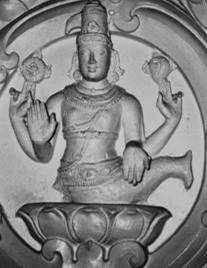



Image used by permission.
Basic Description: Matsya, the 1st avatar of Vishnu, assumed the form of a fish. Matsya retrieved the Vedas for Brahma and saved humanity from the flood.
Mythology: While Brahma was sleeping, the asura Hayagriva stole the Vedas. Vishnu, the preserver God, was watching and pondered how he would retrieve the Vedas from the asura. As he was thinking he saw Sage Satyavrata doing penance in the water and quickly Vishnu assumed the form of a fish. When Satyavrata scooped up the fish, the fish told him not to put him back in the river for fear that he would be eaten. Taking pity on the fish, the Sage took the fish in his Kamandalu back to his home. Through the night and following day the fish kept outgrowing the living spaces he was placed in until he was too large for a pond. The fish kept asking for larger living spaces until it was too big for the largest lake. As Satyavrata tried to place Matsya in the ocean, the fish pleaded with him to not place him in the ocean where he would be eaten. The Sage quickly realized that it was Lord Vishnu in the form of a fish. He worshipped Vishnu and then received Vishnuís instructions. In one week, he was told, the universe would be flooded with water from the ocean. Satyavrata was to get in the spacious boat that would approach him and bring along all the seeds, plants and animals for the next spell of creation. He needed to make sure that Vasuki, the king of serpents, was in the boat. The fish then left and found Hayagriva and slew him, and then retrieved the Vedas from his mouth. The Vedas were then restored to Brahma to use for the creation of the next world. The next week as foretold a great flood covered the Earth, and Matsya towed the boat around until the waters dried up.